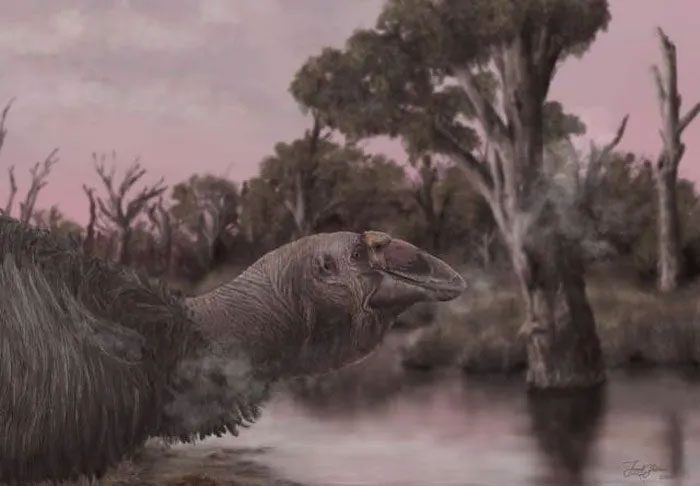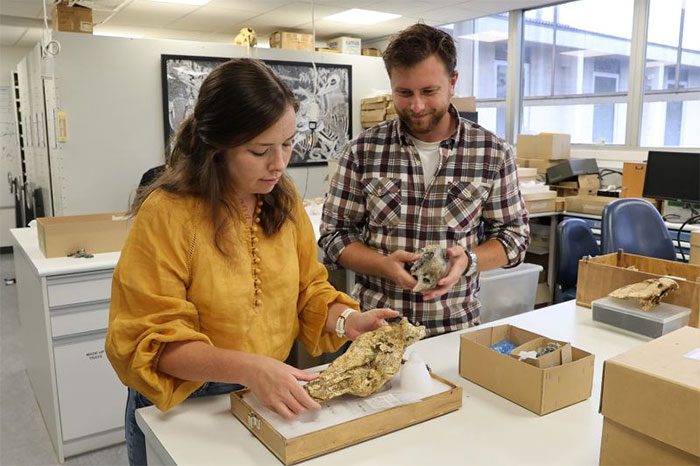The discovery of the fossil of the thunderbird Genyornis newtoni (G. newtoni) not only sheds light on itself but also on the entire Dromornithidae group, a branch of large Australian bird species that are now extinct.
For over a century, scientists have been searching for the skull fossils of the thunderbird G. newtoni, also known as mihirung, but without success. Around 50,000 years ago, these giant birds walked through the forests and grasslands of Australia on their muscular legs. They were taller than humans and weighed hundreds of kilograms.

Simulation image of the giant thunderbird. (Image: CNN).
The mihirung species went extinct approximately 45,000 years ago. The first skull was found in 1913, incomplete and heavily damaged, raising questions about the face, habits, and ancestry of this giant bird.
On June 3, in the journal Historical Biology, scientists reported that the discovery of a complete G. newtoni skull has resolved this long-standing mystery, providing the first direct insight into the giant mihirung.

The skull of G. newtoni, which is helping to answer the long-standing mystery about the face of the giant bird. (Image: Flinders University).
The discovery of the complete skull not only clarifies details about G. newtoni but also about the entire Dromornithidae group, connecting them to modern waterfowl species such as ducks, swans, and geese.
Professor of Anatomy and Paleontology Larry Witmer at Ohio University stated that although scientists have known about G. newtoni for over a century, the new fossils and skull reconstruction provide crucial details that were previously unknown.
G. newtoni stood about 2 meters tall and weighed up to 240 kg. It belonged to the Dromornithidae family, a group of flightless birds known from fossils found in Australia.
“The skull houses the brain and sensory organs, serves as the feeding apparatus, and is often the site for display organs (such as horns, crests…). Additionally, skulls tend to contain structural features that give us clues about their lineage,” Witmer explained.
In the new study, “the authors explored these new fossils with everything they had,” Witmer noted. The researchers not only modeled the bones in the skull; they also analyzed the position of the jaw, ligaments, and other soft tissues that suggest the biological characteristics of the bird.
Paleontologist Phoebe McInerney at Flinders University, the lead author of the study, described G. newtoni as having a very unusual beak, resembling that of a goose. Compared to the skulls of most other birds, its skull is quite short, but the jaw is very massive, supported by strong muscles.

Two co-authors of the study, Phoebe McInerney and Jacob Blokland, next to the skull of Genyornis newtoni. (Image: Flinders University)
The skull indicates the diet of G. newtoni. The flat region of the beak is suitable for tearing soft fruits, shoots, and tender leaves, while the flat palate at the bottom of the upper beak may have been used to crush soft fruits.
“The skull also provides evidence of adaptations for foraging in water, possibly in freshwater environments,” McInerney said. Meanwhile, Witmer remarked that the assumption of underwater foraging for such a giant bird is quite surprising.
The authors of the study placed them in the Anseriformes order of waterfowl. Based on bone structure and related muscles, Dromornithidae could be closely related to the ancestors of modern South American screamers, birds that resemble ducks and inhabit wetlands in southern South America.
While the new insights into G. newtoni are the most accurate to date, the discovery of additional fossils could further refine the portrait of this unusual giant goose, as well as its vanished habitat, according to co-author of the study and avian paleontologist Jacob Blokland.
He stated: “Such a giant and unique bird must have influenced its environment and the other animals it interacted with, whether large or small. Only through research can we build a larger picture and explore what we have been missing.”


















































